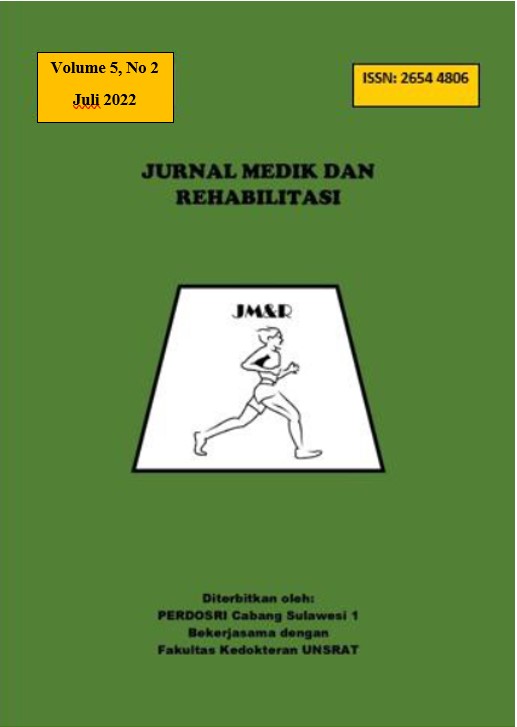PENGARUH LATIHAN INCENTIVE SPIROMETRY DAN DIAPHRAGMATIC BREATHING TERHADAP PENINGKATAN KAPASITAS FUNGSIONAL PASCA-COVID-19
Abstract
Pasca-Covid-19 berhubungan dengan penurunan Kapasitas Fungsional yang dapat mengganggu aktivitas dan pekerjaan sehari-hari. Latihan Incentive Spirometry dan Diaphragmatic Breathing dapat meningkatkan Kapasitas Fungsional pasca-Covid-19. Mengetahui efektivitas latihan Incentive Spirometry dan Diaphragmatic Breathing terhadap peningkatan Kapasitas Fungsional pasca-Covid-19. Penelitian ini merupakan penelitian The Control Group Pre-Post Test Group Design. Sebanyak 11 subjek melakukan 3 set latihan Diaphragmatic Breathing, setiap 1 set berdurasi 5 menit dengan 6 kali siklus nafas dalam 1 menit, frekuensiReferences
Gao Y, Yan L, Huang Y, et al. Structure of the RNA-dependent RNA polymerase from COVID-19 virus. Science 2020;368:779–82.
Gilbert M, Pullano G, Pinotti F, et al. Preparedness and vulnerability of African countries against importations of COVID-19: a modelling study. Lancet 2020;395:871–7.
Singhal T. A Review of Coronavirus Disease-2019 (COVID-19). The Indian Journal of Pediatrics (April 2020). https://doi.org/10.1007/s12098-020-03263-6
Chen N, Zhou M, Dong X, et al. Epidemiological and clinical characteristics of 99 cases of 2019 novel coronavirus pneumonia in Wuhan, China: a descriptive study. Lancet 2020;395:507–13.
Joseph T, Ashkan M. International Pulmonologist’s Consensus On COVID-19. India; 2020
WHO. WHO Coronavirus Disease (COVID-19) Dashboard. Available online : https://covid19.who.int/
Ozakinci H, Sak SD. Lung Pathology in COVID-19 Disease: We Must Be Aware!. Turk Thorac J. 2020 May; 21(3): 217–218. doi: 10.5152/TurkThoracJ.2020.20049
Nila SH et. Al. COVID-19: Pathogenesis,cytokine storm and therapeutic potential of interferon. Cytokine & Growth Factor Reviews Volume 53, June 2020, p. 66-70. https://doi.org/10.1016/j.cytogfr.2020.05.002
Mo X, et.al. Abnormal pulmonary function in COVID-19 patients at time of hospital discharge.Research Article.Eur Respi J.2020
Goërtz YMJ, Van Herck M, Delbressine JM, et al. Persistent symptoms 3 months after a SARS-CoV-2 infection: the post-COVID-19 syndrome?. ERJ Open Res 2020; in press (https://doi.org/10.1183/23120541.00542-2020).
Zhu ¬F, et al. Effects of respiratory rehabilitation on patients with novel coronavirus (COVID-19) pneumonia in the rehabilitation phase: protocol for asystematic review and meta-analysis. BMJ Open 2020. doi:10.1136/bmjopen-2020-039771
Wang TJ, et. al. Physical Medicine and Rehabilitation and Pulmonary. Am J Phys Med Rehabil 2020. doi :10.1097/PHM.0000000000001505
Lunardi AC, et.al. Effect of Volume-Oriented versus Flow-Oriented Incentive Spirometry on Chest Wall Volumes, Inspiratory Muscle Activity, and Thoracoabdominal Synchrony in the Elderly. Respiratory care. March 2014. doi : 10.4187/respcare.02665
Basoglu OK et.al. The efficacy of incentive spirometry in patients with COPD. Original article. Respirology. 2005. p349-353
Hussin A. Rothan and Siddappa N. Byrareddy. (2020). The epidemiology and pathogenesis of coronavirus disease (COVID-19) outbreak. Journal of Autoimmunity,. https://doi.org/10.1016/j.jaut.2020.102433
Niu S, Tian S, Lou J, Kang X, Zhang L, Lian H, et al. Clinical characteristics of older patients infected with COVID-19: a descriptive study. Arch Gerontol Geriatr. 2020;89:104058.
Karyono DR, Wicaksana AL. Current prevalence, characteristics, and comorbidities of patients with COVID-19 in Indonesia. Original article. Journal of Community Empowerment for Health. August 2020. doi:10.22146/jcoemph.57325
Blough SH, et.al. Prevalence of COVID-19: A Look behind the Scenes. Mini review. Aoril 2020. doi: 10.20944/preprints202004.0179.v2
Wang Z, Qiang W, Ke H. A Handbook of 2019-nCoV Pneumonia Control and Prevention. Hubei Science and Technologi Press. China; 2020.
Fehr AR, Perlman S. Coronavirus: An Overview of Their Replication and Pathogenesis. Methods Mol Biol. 2015 ; 1282: 1–23.
Korsman SNJ, van Zyl GU, Nutt L, Andersson MI, Presier W.Virology. Chins: Churchill Livingston Elsevier; 2012
Huang C, Wang Y, Li X, Ren L, Zhao J, Zang Li, Fan G. Clinical features of patients infected with 2019 novel coronavirus in Wuhan, China. The Lancet. 24 jan 2020.
Li-sheng Wang , Yi-ru Wang , Da-wei Ye , et al. Review of the 2019 Novel Coronavirus (COVID-19) based on current evidence. International Journal of Antimicrobial Agent. (2020). doi: 10.1016/j.ijantimicag.2020.105948
World Health Organization. Clinical management of severe acute respiratory infection when novel coronavirus (2019-nCoV) infection is suspected. interim guidance. [Serial on The Internet]. Cited Jan 30th 2020. Available on: https://www.who.int/publications-detail/clinical-management-ofsevere-acute-respiratory-infection-when-novel-coronavirus-(ncov)-infection-is-suspected.(Jan 28th 2020)
Perhimpunan Dokter Paru Indonesia. Panduan Praktik Klinis: Pneumonia 2019-nCoV. PDPI: Jakarta; 2020.
Cozzi D, et. Al. Chest X‑ray in new Coronavirus Disease 2019 (COVID‑19) infection:findings and correlation with clinical outcome. Chest Radiology.2020
Tenda DE, et. Al.The Importance of Chest CT Scan in COVID-19: A Case Series.Acta Med Indones - Indones J Intern Med.2020
Mohamed AA, Alawna M. Role of increasing the aerobic capacity on improving the function of immune and respiratory systems in patients with coronavirus (COVID-19): A review. Diabetes Metab Syndr. 2020 July-August. doi: 10.1016/j.dsx.2020.04.038
Yuki K, et.al. COVID-19 pathophysiology. Clin Immunol. June 2020. doi: 10.1016/j.clim.2020.108427
Gulhan PY, et.al. Interstitial lung diseases and COVID‑19. Eurasian journal of pulmonology. August 2020. doi: 10.4103/ejop.ejop_46

